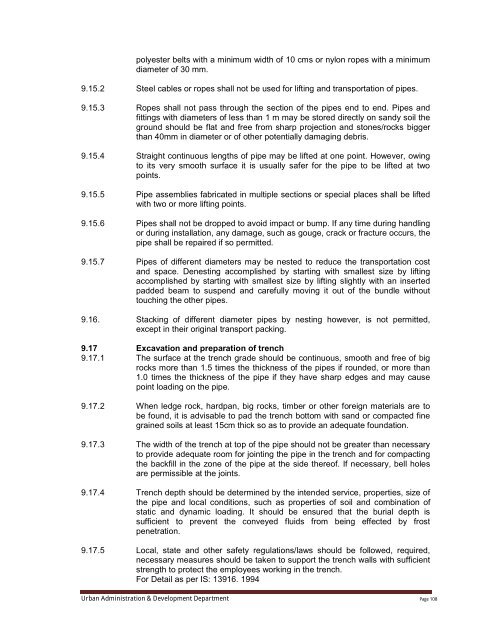Specifications Part 1 - Water Supply, Sewerage and Tube Well Works
Specifications Part 1 - Water Supply, Sewerage and Tube Well Works
Specifications Part 1 - Water Supply, Sewerage and Tube Well Works
You also want an ePaper? Increase the reach of your titles
YUMPU automatically turns print PDFs into web optimized ePapers that Google loves.
polyester belts with a minimum width of 10 cms or nylon ropes with a minimumdiameter of 30 mm.9.15.2 Steel cables or ropes shall not be used for lifting <strong>and</strong> transportation of pipes.9.15.3 Ropes shall not pass through the section of the pipes end to end. Pipes <strong>and</strong>fittings with diameters of less than 1 m may be stored directly on s<strong>and</strong>y soil theground should be flat <strong>and</strong> free from sharp projection <strong>and</strong> stones/rocks biggerthan 40mm in diameter or of other potentially damaging debris.9.15.4 Straight continuous lengths of pipe may be lifted at one point. However, owingto its very smooth surface it is usually safer for the pipe to be lifted at twopoints.9.15.5 Pipe assemblies fabricated in multiple sections or special places shall be liftedwith two or more lifting points.9.15.6 Pipes shall not be dropped to avoid impact or bump. If any time during h<strong>and</strong>lingor during installation, any damage, such as gouge, crack or fracture occurs, thepipe shall be repaired if so permitted.9.15.7 Pipes of different diameters may be nested to reduce the transportation cost<strong>and</strong> space. Denesting accomplished by starting with smallest size by liftingaccomplished by starting with smallest size by lifting slightly with an insertedpadded beam to suspend <strong>and</strong> carefully moving it out of the bundle withouttouching the other pipes.9.16. Stacking of different diameter pipes by nesting however, is not permitted,except in their original transport packing.9.17 Excavation <strong>and</strong> preparation of trench9.17.1 The surface at the trench grade should be continuous, smooth <strong>and</strong> free of bigrocks more than 1.5 times the thickness of the pipes if rounded, or more than1.0 times the thickness of the pipe if they have sharp edges <strong>and</strong> may causepoint loading on the pipe.9.17.2 When ledge rock, hardpan, big rocks, timber or other foreign materials are tobe found, it is advisable to pad the trench bottom with s<strong>and</strong> or compacted finegrained soils at least 15cm thick so as to provide an adequate foundation.9.17.3 The width of the trench at top of the pipe should not be greater than necessaryto provide adequate room for jointing the pipe in the trench <strong>and</strong> for compactingthe backfill in the zone of the pipe at the side thereof. If necessary, bell holesare permissible at the joints.9.17.4 Trench depth should be determined by the intended service, properties, size ofthe pipe <strong>and</strong> local conditions, such as properties of soil <strong>and</strong> combination ofstatic <strong>and</strong> dynamic loading. It should be ensured that the burial depth issufficient to prevent the conveyed fluids from being effected by frostpenetration.9.17.5 Local, state <strong>and</strong> other safety regulations/laws should be followed, required,necessary measures should be taken to support the trench walls with sufficientstrength to protect the employees working in the trench.For Detail as per IS: 13916. 1994Urban Administration & Development Department Page 108
















